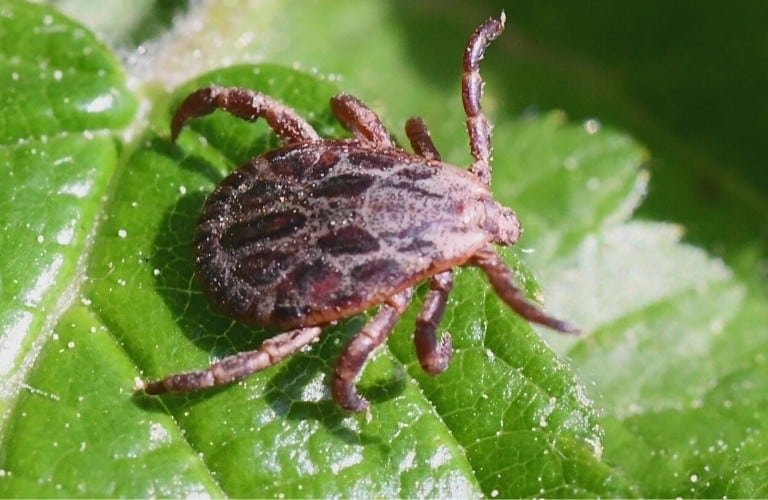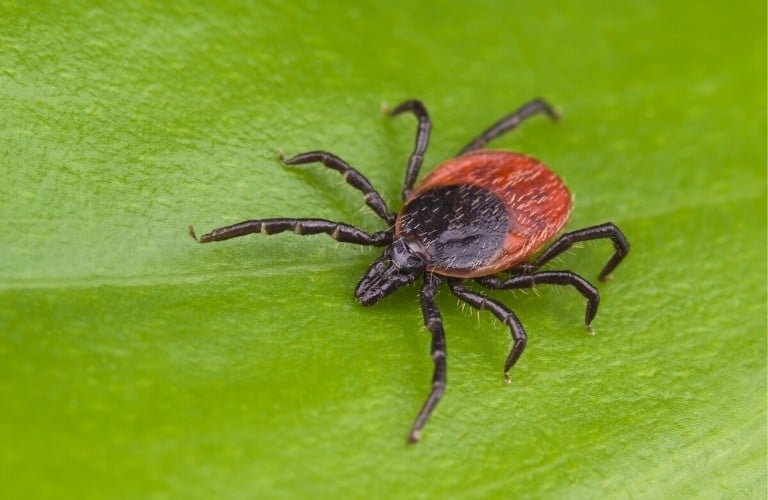It’s important to know where ticks live, especially if you’re traveling to somewhere you’re not familiar with.
The last thing you want is to end your hiking trip removing ticks because you went trekking through an area you didn’t expect to have ticks.
Where do ticks live? Ticks prefer warm and humid areas where they can stay active all year long. They can live in colder areas but will go dormant in the winter. They live on hosts to feed and mate but do most of their egg laying and molting in leaf piles, tall grass, and forest floors.
In the following, you’ll learn more about the locations and climates ticks like to live as well as where they like to bite and what you can do to protect yourself.
The Tick’s Preferred Climate
The ideal climate for ticks is warm and humid. They like at least 85% humidity but can tolerate lower levels.
The United States has an average humidity range of 71-82%, according to USA.com.
These numbers can fluctuate, of course, but since the average is right below the ideal level, that means that a lot of states can sustain ticks.
The states where ticks are more commonly found are in the Northeast, the West and East Coasts, and the Southern states.
These areas are generally pretty humid during tick season (find out exactly when ticks become active here) and have plenty of trees and bushes around, making them the perfect places for ticks to thrive.
Ticks can’t move around with temperatures less than 44°F (7°C), so in many of the Northern states that have ticks, there will be fewer ticks because they go dormant.
Freezing temperatures won’t kill them, so you can expect to see them again in the spring.
Hot and dry climates like Arizona, New Mexico, and part of Texas are less likely to see ticks since they don’t typically have the humidity levels needed to sustain them.
They might still have them, but they won’t be as common as in other parts of the United States.
Where Ticks Like to Live
Before you head outside in a national park or just in your backyard, you should know where to look for ticks.
They’re small and prefer humidity, which means they’re more likely to be found down low in bushes and grass. They can’t jump or fly, so they’ll stick to what’s easy to reach.
Grass
Grassy areas are good places for ticks to live. Grass can grow tall, hosts are more likely to go through the area, and grass tends to be a little more humid than other areas.
An unkempt yard or grassy clearing in the woods is bound to be the home of hundreds of ticks. Ticks can easily grab onto hosts’ feet or legs or if it’s a mouse, their entire body.
Bushes
Bushes provide plenty of protection and allow the ground underneath to stay moist, even when it’s hot. They’re the perfect place for ticks to thrive.
They give ticks easier access to bigger hosts since they can crawl up the branches and leaves. Bushes make it easier for them to latch onto you, big dogs, and horses.
Tree Branches
Ticks don’t usually live in big trees, but they will occasionally live in smaller ones. They have to climb a long way, but they have great access to humans and large animals.
If a branch brushes against you, you might end up with a few ticks in your hair or on your shoulder.
Branches don’t provide much protection or humidity though, so they won’t always choose them.
Piles of Debris
Whether it’s a stack of wood, grass clippings from your mower, or fallen leaves, ticks enjoy piles.
There’s plenty of protection and moisture, and they serve as a home for many critters like mice, so ticks have easy access to their next blood meal.
Debris piles are their favorite places to live. They’ll mate, lay eggs, and molt in these piles, so it’s best to keep piles of all kinds out of your yard.
Dispose of raked leaves and lawn clippings in the garbage or in a compost pile far from your home.
If you have pets that roam the yard, they’ll probably pick up ticks from piles.
Walls
Walls made from rocks, bricks, or other porous materials might serve as an apartment complex for ticks.
If the material is absorbent enough to hold moisture, it’s good enough for a tick. They’ll climb up the wall and make themselves right at home.
If this wall is your house, they might find their way inside. If it’s located in your backyard, leaning against it will allow you or your pet to bring them inside.
Be sure to check with our article “How To Get Rid of Ticks” for a complete guide for both tick prevention and elimination strategies.
Ticks Also Live Indoors
Tick infestations can happen inside, with or without pets.
They’re more common if you have a dog or cat that is allowed to roam indoors and outdoors, but humans are hosts, too, and you’re enough of a reason for a tick to hitch a ride inside.
Ticks don’t like to live inside because they prefer to lay their eggs in soil, but they’ll crawl around and look for somewhere to stay like carpet, moist bathroom rugs, or laundry piles.
Pet beds are a common place for them to stay, especially if a pet frequently uses it.
If you end up with ticks in your home, Natural Care Flea and Tick Carpet Powder is a great product to kill them with.
It relies on essential oils, diatomaceous earth, and other natural ingredients to kill the ticks.
Once you apply the powder to your carpet and furniture, allow it to sit for a few hours and then vacuum it up.
Where Ticks Like to Bite
Unfortunately, your yard and carpet aren’t the only places where ticks live – they’ll also inhabit your body while they feed on you. They prefer dark and moist areas, including:
- Ears.
- Hair.
- Armpits.
- Bra line.
- Waist.
- Groin.
- Behind the knees and elbows.
- Ankles, feet, and in between toes.
Ticks will bite anywhere, so after you spend time outdoors, you should check your entire body for ticks.
Learn what symptoms are normal following a tick bite and which symptoms may warrant a trip to the doctor in this article.
Ticks can range anywhere from 1-10 millimeters in size, so they may be hard to see.
A hot shower will remove ticks that haven’t bitten you and might even encourage attached ticks to let go.
Of course, it’s better to keep ticks away in the first place than to hunt all over your body for them while you’re showering.
A tick repellent spray will discourage ticks from choosing you as their next host. (See all our tick spray recommendations here.)
Repel Lemon Eucalyptus Insect Repellent is a natural, plant-based spray with a pleasant, fresh scent and no greasy residue.
Thanks to the addition of oil of lemon eucalyptus, the spray should keep repelling for up to six hours.
Removing Ticks
The CDC recommends tweezers as the safest option to remove ticks. They allow you to grab the tick extremely close to its head and pull straight up without twisting.
(You’ll find complete instructions for tick removal here.)
If you don’t have tweezers or would rather use an alternative method, there are plenty of products you can buy that makes removing them easier.
They’re not recommended by the CDC, so they might not be the safest. Just be extra careful when you’re using something other than tweezers.
The Original Ticked Off Tick Remover is a good option because it makes disposal easy and prevents you from touching the tick with your hands.
It looks like a teaspoon with a notch in it. The notch is meant to grab the tick. Once it’s out of your skin, it will fall into the cup so you can easily take it to the toilet to be flushed.
Final Thoughts
Ticks prefer humid and warm climates. If temperatures drop below freezing in the winter, they will go dormant and emerge in the spring.
Ticks like to live in protected areas like tall grass and leaf piles because they can climb and reach their hosts more easily.
Backyards and camping sites are full of tick real estate, so be careful and stay alert when you head outside.
Dealing with ticks is never pleasant, but being armed with plenty of information is your best line of defense.
Click here to see our full lineup of tick articles and learn how to prevent bites and infestations and what to do if ticks are already invading your yard.






